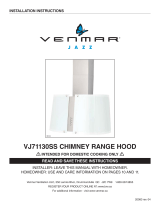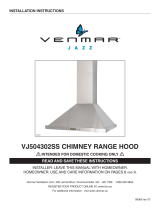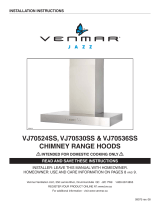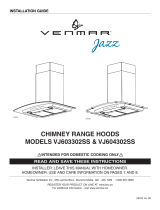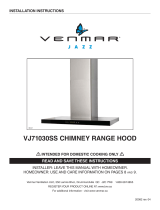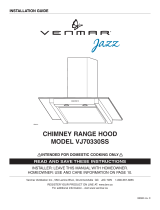PAGE 4
BEFORE INSTALLATION
EXHAUST-AIR MODE
BEFORE INSTALLATION
For optimum hood efficiency:
The exhaust air is discharged upwards through a duct or
directly through an exterior wall to the outdoors.
D
Exhaust air should neither be directed into a smoke or
exhaust flue (chimney) that is currently used for other pur-
poses nor into a duct that is used for ventilating rooms in
which stoves or fireplaces are also located.
Exhaust air may be discharged in accordance with
official and statutory regulations only (e.g. national
building regulations).
Local government regulations must be observed when
discharging air into smoke or exhaust flues that are not
otherwise in use.
D
When the extractor hood is operated in exhaust-air
mode simultaneously with a different heating system
that also makes use of the same chimney (such as
gas, oil or coal-fired heaters, continuous-flow heaters, hot-
water boilers), care must be taken to ensure that there is
an adequate supply of fresh air, which will be needed
by the heating system for combustion.
Safe operation is possible provided that the negative pres-
sure in the room where the heating system is installed
does not exceed 4 Pa (0.04 mbar).
This can be achieved if combustion air can flow through
non-lockable openings, such as doors, windows and
through the air-intake/exhaust-air wall box.
WARNING – Avoid risk of poisoning – If the air intake
is inadequate, there is a risk of poisoning from com-
bustion gases that are drawn back into the room.
Note: When assessing the overall requirements, the com-
bined ventilation system for the entire household must be
taken into consideration. This rule does not apply to the
use of cooking appliances, such as cooktops and ovens.
Unrestricted operation is possible if the extractor hood is
used in recirculating mode – with activated carbon filters.
If the exhaust air is going to be discharged to the out-
doors, a telescopic wall box should be fitted into the out-
side wall.
❑ Short, smooth ductwork.
❑
As few bends in the ductwork as possible.
❑
Diameter of ductwork to be as wide as
possible with no tight bends in ductwork.
If using long, rough exhaust-air ductwork, several
duct elbows or ductwork with a narrower diameter,
the rate of air extraction will no longer be at an
optimum level and there will be an increase in
noise.
IMPORTANT: The manufacturer of the hood
accepts no liability for complaints which can be
attributed to the design and layout of the duct-
work.
❑
Round duct sections:
Recommended
internal diameter: 6”/10”.
❑
Flat ducts must have an internal cross-section equal
to that of round duct sections.
l 6” approx. 28.3 inches
2
❑
If ducts have different diameters:
Insert sealing strip for transition.
❑
For exhaust-air mode, ensure that there is an
adequate supply of fresh air.










